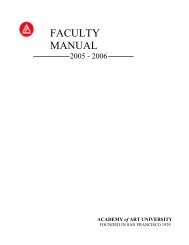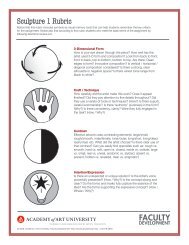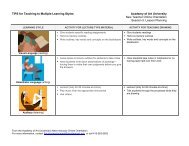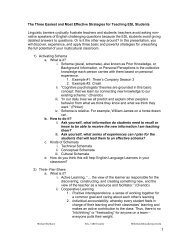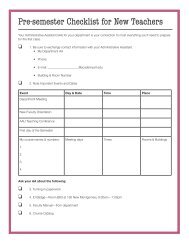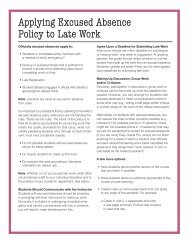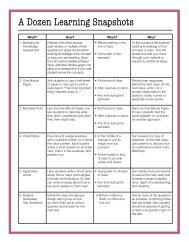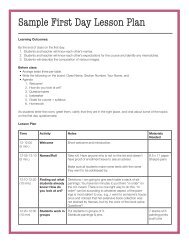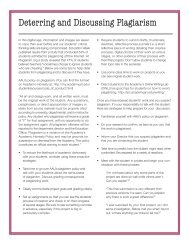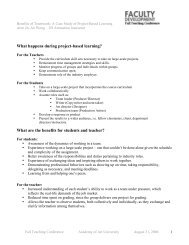Building a Common Vocabulary for Design Critiques AAU Teaching ...
Building a Common Vocabulary for Design Critiques AAU Teaching ...
Building a Common Vocabulary for Design Critiques AAU Teaching ...
You also want an ePaper? Increase the reach of your titles
YUMPU automatically turns print PDFs into web optimized ePapers that Google loves.
<strong>Building</strong> a <strong>Common</strong> <strong>Vocabulary</strong> <strong>for</strong> <strong>Design</strong> <strong>Critiques</strong><strong>AAU</strong> <strong>Teaching</strong> Conference August 25 th , 2005Presenter: Carol Koffel, IDS InstructorFacilitator explained concepts of Bridging and <strong>Building</strong> according to Andrew Hargadon –U C Davis. Also referred to Michael Ray’s Creativity in Business. Discussed with theparticipants some challenges they have had in conducting critiques. Many shared Carol’sopinion that students lack the vocabulary to articulate a good critique. Suggestions <strong>for</strong>critiques follow:During <strong>Critiques</strong>: Students have to be responsible <strong>for</strong> in<strong>for</strong>mation. They can becomeresponsible to each other.• Students take notes <strong>for</strong> each other (each student hand his notebook to anotherstudent during the critique so that the one being critiqued can listen andparticipate, while the notetaker can focus on recording the specific points andsuggestions).• Teacher writes key points on boardWhat other methods can students use to encourage self-discovery? Participantsbrainstormed many ideas including the following:1. Identify words & phrases we can’t use: ex: “I like it”, or “it’s good”, “tight”“interesting”2. Constructive criticism-use course related vocabulary3. Deconstruction- use critique to understand the process & principles of art4. Create a glossary-terms and definitions5. Role-play. Incorporate roles, such as designer, client, model maker, director, orother roles into critique to give students various perspectives to analyze art.6. Create a com<strong>for</strong>table environment to unlock creativity and self discovery.7. Dissuade collusion- cut off comments that have already been stated and set clearground rules8. Foster collaboration- one student may know value really well, while another maydraw really well.
HANDOUT: Sample critique checklist from Carol Koffel’s class_________________ Academy of Art University PD 6 spring 05Desk <strong>Critiques</strong>: Last week, I went around and coached each of you on your projects. This week, I’d like you to reflect theteaching you received in a written <strong>for</strong>mat. The goal is <strong>for</strong> each of you to become reflective listeners and learn to be selfdirected.• Outline the key talking points from last week’s desk critique (what was discussed, what actions were you to take)• Outline ACTIONS you took in this week’s homework (where did you focus your energy on this past week)• Outline ACTIONS required in the next three weeks• List any questions or additional in<strong>for</strong>mation (ideas or areas where you need to get started, keep going and besuccessful)• List suggestions that you elected not to follow and why: (Ideas or critiques are given from another’s viewpoint and maynot be right <strong>for</strong> your project or your design sense. Be sure to understand and explain why the suggestion or direction is notone you will follow. This discussion is critical to your success as a designer / consultant or person in relationship)
_________________ Academy of Art University PD 6 (Product <strong>Design</strong> 6) spring 05Student <strong>Critiques</strong>:Spend 15 minutes reviewing your assigned groups work. Then write a critique that will be passed along unanimously toeach designer via the teacher in desk critique review. Evaluate the following items:1> Clear Problem Statement/Opportunity <strong>for</strong> Innovation:(is this a compelling issue / is the problem statement clear and simple – can you offer a suggestion)Having a clear problem and one that is narrow will help as we begin to design. A clear problemmakes decisions actionable. Many decisions are trade offs between multiple needs/desires.2> Research:Diagram Types:____ 2 x 2 matrix____ x/y axis matrix____ timeline____ process outline____ user profile / ethnographic story____SWOT (strengths. weaknesses, opportunities, threats)____STEP (social, technological, economic, political)____mind mapping____ synthesis - 3 key pointsStakeholders:____ user____ technology____ marketing____ manufacturing____ materials____ financial3> Sketching:4> Concept:____ paper and tool alignment____ page composition (negative/positive space) ( graphic call outs) (titles)____ line quality____ value contrast____ scale____ perspective____ section line expression of surfaces____ parting lines – expression of manufacturing____ supports / changes the design assignment____ expands on research findings (opportunity and problems)____ expression of “attitude” (leads to design details)____ expression of design (materials/color/use models)____ideas (progression of thoughts) (drawings tell a story) (one page/one idea)____ innovation (integration of research into ideation)____ grouping of common themes____ number of themes____ clear expression of thinking process____ ergonomics____ sustainability____ socially responsible____ marketing angle____ materials____ simplification of complex areas5> Architectural Configuration: (what is inside, how it works, and how to arrange it)____ components____ exploded view____ parts definition____ alternate arrangements (weight, size, stack, ergonomics)____ shrink the package____ cost implications6> Rough Prototyping: (who can they show it to get feed back – is it easy to use – can you offer a suggestion)
____ quality of model____ iterations____ scale____ part break up____ ergonomics – user experience____ point of purchase experience____ appropriate solution supported by concept/sketching/architectural config____ learning’s to in<strong>for</strong>m other facets of designA rough prototype can stimulate conversations and interviews with user groups that can in<strong>for</strong>m design when theproduct is in a very fluid and non-committed state. You want to understand the interface requirements, culturalinfluences, and define the best experience in your product. Listen, don’t speak - ask open-ended questions –observe behaviors and notice the invisible.7> <strong>Design</strong> Detailing and Refinements: (identify areas <strong>for</strong> design detailing focus - can you offer a design detail)____ scale/ergonomics____ theme <strong>for</strong> detailing____ logo or branding____ use of part lines as an aesthetic value____ color/materials____ iconic design features____ point of purchase understanding of product____ simplify____ assembly8> Expand the narrow problem statement to include stream of consciousness stories: (inside/outside)Once we learn about a narrow problem, we are often given key phrases or needs, that can be expanded uponto create products that offer incredible experiences, cultural paradigm shifts andsimple solutions to common everyday problems. Inside the box/outside of the box thinking is required. Think of theproblem space and not the solution of the design – until you have recorded the entire scope of experiences and potentialframeworks and scenarios.Once you have defined the problem space and all potential scenarios, select a design direction. Adopting adesign that is closest to solving the problem statement; envision users engaging with the product, exploreergonomic issues, engineering constraints, surface geometry that defines a better understanding, scale thefeatures <strong>for</strong> a great aesthetic outcome, and lead yourself to design refined details on exquisite products.9> Verbal:____ declaration of what want from critique____ three or four key points (tell them what you will say, tell them, tell them what you told them)____ visual support <strong>for</strong> everything____ quality of voice____ status of body language____ content of story (clarity, questions, confusion, missed opportunity)



